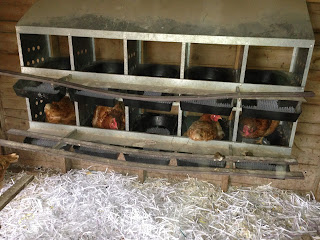We currently have a small flock of about 35 laying hens. Barb also raises 50 broilers every year. They are a fun hobby that keeps us and the neighbors in eggs and meat.
Since Barb is gone for a few days I get to take care of her hens and the chicks that will replace them this summer and fall. We currently have mostly red sex-linked hens, but a few years ago we had chickens of many breeds. Our daughters showed chickens in 4-H and they needed purebred chickens to show. As a result our hen flock was quite colorful and our eggs were also quite varied in color.
These chicks are about 3 weeks old. The little red and black chicks will be the new laying hens. The large white chicks are broilers. They will be ready to butcher in 4 more weeks. They are breed to grow very fast.
 |
Feeding time. We take the feed away from the chicks at night so they don't overgorge themselves. The broilers will actually eat themselves to death if the feed is not limited. In the morning they are starved.
 We use heat lamps to keep the chicks warm. The first couple of days we try to keep their house at 90 degrees. Now we are shooting for 75 degrees. This shouldn't be an issue in late April, but not this year. It is supposed to get down to 26 tonight (April 22).
We use heat lamps to keep the chicks warm. The first couple of days we try to keep their house at 90 degrees. Now we are shooting for 75 degrees. This shouldn't be an issue in late April, but not this year. It is supposed to get down to 26 tonight (April 22).
This is our freshly cleaned layer house. With the cold wet weather I helped scoop and haul the chicken litter out to the garden. We use shredded paper for litter. The hens love to scratch it around and it catches their waste and makes clean up fairly easy.
Our 10 hole layer box. This is where we want the hens to lay their eggs. The bottoms are sloped so the eggs roll out to the front. Some hens prefer to make their own nest and we have to go find them every day.
These are the eggs from 2 days of laying for our hens. You will notice the variety of colors including a few that are blue-green. These are from a special breed of chickens that lay eggs with a colored shell. The color of the shell makes no difference to the color of the egg inside.
Happy free range chickens. We have a large area for the hens to run around on. We have an electric fence about 6 inches from the ground to keep the dogs and other critters out and helps keep the chicken in. We also have a taller netting fence on the yard side as well. Sometimes we have to clip the feathers from one wing to keep the chickens from flying out.




No comments:
Post a Comment